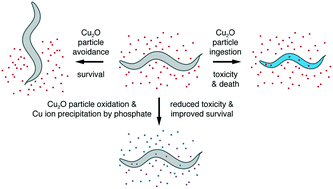当前位置:
X-MOL 学术
›
Environ. Sci.: Nano
›
论文详情
Our official English website, www.x-mol.net, welcomes your
feedback! (Note: you will need to create a separate account there.)
Identification of toxicity effects of Cu2O materials on C. elegans as a function of environmental ionic composition
Environmental Science: Nano ( IF 5.8 ) Pub Date : 2020/01/08 , DOI: 10.1039/c9en00686a Catherine J. Munro 1, 2, 3, 4 , Michelle A. Nguyen 1, 2, 3, 4 , Christian Falgons 1, 2, 3, 4, 5 , Sana Chaudhry 2, 3, 4, 5 , Mary O. Olagunju 1, 2, 3, 4 , Addys Bode 2, 3, 4, 5 , Carla Bobé 1, 2, 3, 4, 5 , Manuel E. Portela 1, 2, 3, 4, 5 , Marc R. Knecht 1, 2, 3, 4 , Kevin M. Collins 2, 3, 4, 5
Environmental Science: Nano ( IF 5.8 ) Pub Date : 2020/01/08 , DOI: 10.1039/c9en00686a Catherine J. Munro 1, 2, 3, 4 , Michelle A. Nguyen 1, 2, 3, 4 , Christian Falgons 1, 2, 3, 4, 5 , Sana Chaudhry 2, 3, 4, 5 , Mary O. Olagunju 1, 2, 3, 4 , Addys Bode 2, 3, 4, 5 , Carla Bobé 1, 2, 3, 4, 5 , Manuel E. Portela 1, 2, 3, 4, 5 , Marc R. Knecht 1, 2, 3, 4 , Kevin M. Collins 2, 3, 4, 5
Affiliation

|
Previous work has shown that spherical CuO nanomaterials show negative effects on cell and animal physiology. The biological effects of Cu2O materials, which possess unique chemical features compared to CuO nanomaterials and can be synthesized in a similarly large variety of shapes and sizes, are comparatively less studied. Here, we synthesized truncated octahedral Cu2O particles and characterized their structure, stability, and physiological effects in the nematode worm animal model, Caenorhabditis elegans. Cu2O particles were found to be generally stable in aqueous media, although the particles did show signs of oxidation and leaching of Cu2+ within hours in worm growth media. The particles were found to be especially sensitive to inorganic phosphate (PO43−) found in standard NGM nematode growth medium. Cu2O particles were observed being taken up into the nematode pharynx and detected in the lumen of the gut. Toxicity experiments revealed that treatment with Cu2O particles caused a significant reduction in animal size and lifespan. These toxic effects resembled treatment with Cu2+, but measurements of Cu leaching, worm size, and long-term behavior experiments show the particles are more toxic than expected from Cu ion leaching alone. These results suggest worm ingestion of intact Cu2O particles enhances their toxicity and behavior effects while particle exposure to environmental phosphate precipitates leached Cu2+ into biounavailable phosphate salts. Interestingly, the worms showed an acute avoidance of bacterial food with Cu2O particles, suggesting that animals can detect chemical features of the particles and/or their breakdown products and actively avoid areas with them. These results will help to understand how specific, chemically-defined particles proposed for use in polluted soil and wastewater remediation affect animal toxicity and behaviors in their natural environment.
中文翻译:

确定Cu2O材料对秀丽隐杆线虫的毒性作用与环境离子组成的关系
先前的工作表明,球形CuO纳米材料对细胞和动物生理学具有负面影响。与CuO纳米材料相比具有独特化学特征并且可以以相似的多种形状和尺寸合成的Cu 2 O材料的生物效应,研究相对较少。在这里,我们合成了截短的八面体Cu 2 O颗粒,并在线虫蠕虫动物模型秀丽隐杆线虫中表征了其结构,稳定性和生理效应。发现Cu 2 O粒子在水性介质中通常稳定,尽管该粒子确实显示出Cu 2+的氧化和浸出迹象。在蠕虫生长培养基中数小时之内。发现该颗粒对在标准NGM线虫生长培养基中发现的无机磷酸盐(PO 4 3-)特别敏感。观察到Cu 2 O颗粒被吸入线虫咽并在肠腔中被检测到。毒性实验表明,用Cu 2 O颗粒处理会导致动物体型和寿命大大降低。这些毒性作用类似于使用Cu 2+进行处理,但是对Cu浸出,蠕虫大小和长期行为实验的测量表明,这些颗粒的毒性比单独使用Cu离子浸出所预期的毒性更大。这些结果表明蠕虫摄入完整的Cu 2O颗粒增强了其毒性和行为效果,而颗粒暴露于环境磷酸盐沉淀会使Cu 2+浸入生物无法利用的磷酸盐中。有趣的是,蠕虫显示出可以避免使用含Cu 2 O颗粒的细菌性食物,这表明动物可以检测出颗粒和/或其分解产物的化学特征,并积极地避开它们的区域。这些结果将有助于了解提议用于污染土壤和废水修复的特定化学定义的颗粒如何影响动物毒性及其在自然环境中的行为。
更新日期:2020-02-20
中文翻译:

确定Cu2O材料对秀丽隐杆线虫的毒性作用与环境离子组成的关系
先前的工作表明,球形CuO纳米材料对细胞和动物生理学具有负面影响。与CuO纳米材料相比具有独特化学特征并且可以以相似的多种形状和尺寸合成的Cu 2 O材料的生物效应,研究相对较少。在这里,我们合成了截短的八面体Cu 2 O颗粒,并在线虫蠕虫动物模型秀丽隐杆线虫中表征了其结构,稳定性和生理效应。发现Cu 2 O粒子在水性介质中通常稳定,尽管该粒子确实显示出Cu 2+的氧化和浸出迹象。在蠕虫生长培养基中数小时之内。发现该颗粒对在标准NGM线虫生长培养基中发现的无机磷酸盐(PO 4 3-)特别敏感。观察到Cu 2 O颗粒被吸入线虫咽并在肠腔中被检测到。毒性实验表明,用Cu 2 O颗粒处理会导致动物体型和寿命大大降低。这些毒性作用类似于使用Cu 2+进行处理,但是对Cu浸出,蠕虫大小和长期行为实验的测量表明,这些颗粒的毒性比单独使用Cu离子浸出所预期的毒性更大。这些结果表明蠕虫摄入完整的Cu 2O颗粒增强了其毒性和行为效果,而颗粒暴露于环境磷酸盐沉淀会使Cu 2+浸入生物无法利用的磷酸盐中。有趣的是,蠕虫显示出可以避免使用含Cu 2 O颗粒的细菌性食物,这表明动物可以检测出颗粒和/或其分解产物的化学特征,并积极地避开它们的区域。这些结果将有助于了解提议用于污染土壤和废水修复的特定化学定义的颗粒如何影响动物毒性及其在自然环境中的行为。











































 京公网安备 11010802027423号
京公网安备 11010802027423号